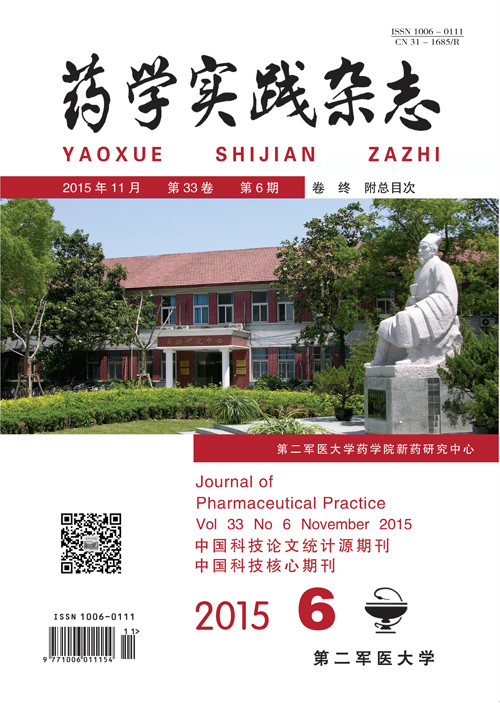|
[1]
|
David S, Pitard B, Benoit JP, et al. Non-viral nanosystems for systemic siRNA delivery[J].Pharmacol Res, 2010,62(2): 100-114. |
|
[2]
|
Tiemann K, Rossi JJ. RNAi-based therapeutics-current status, challenges and prospects[J].EMBO Mol Med, 2009, 1(3): 142-151. |
|
[3]
|
Liu W, Chen JM. Progress in studies of the structure-activity relationship of cationic lipid-mediated gene delivery[J].Chin J New Drug, 2011,20( 20): 1975-1980. |
|
[4]
|
Yang ST, Zaitseva E, Chernomordik LV, et al. Cell-penetrating peptide induces leaky fusion of liposomes containing late endosome-specific anionic lipid[J].Biophys J,2010, 99(8): 2525-2533. |
|
[5]
|
Han SE, Kang H, Shim GY, et al. Novel cationic cholesterol derivative-based liposomes for serum-enhanced delivery of siRNA[J].Int J Pharm, 2008,353(1-2): 260-269. |
|
[6]
|
Maslov MA, Kabilova TO, Petukhov IA, et al. Novel cholesterol spermine conjugates provide efficient cellular delivery of plasmid DNA and small interfering RNA[J].J Control Release, 2012, 160(2): 182-193 |
|
[7]
|
Kim J, Kim SW, W Kim WJ. PEI-g-PEG-RGD/small interference RNA polyplex-mediated silencing of vascular endothelial growth factor receptor and its potential as an anti-angiogenic tumor therapeutic strategy[J].Oligonucleotides, 2011,21(2): 101-107. |
|
[8]
|
Malek A, Czubayko F, Aigner A. PEG grafting of polyethylenimine (PEI) exerts different effects on DNA transfection and siRNA-induced gene targeting efficacy[J].J Drug Target, 2008, 16(2): 124-139. |
|
[9]
|
Xia W, Wang P, Lin C, et al. Bioreducible polyethylenimine-delivered siRNA targeting human telomerase reverse transcriptase inhibits HepG2 cell growth in vitro and in vivo[J].J Control Release, 2012, 157(3): 427-436. |
|
[10]
|
Yu T, Liu X. Bolcato-Bellemin AL,et al. An amphiphilic dendrimer for effective delivery of small interfering RNA and gene silencing in vitro and in vivo[J].Angew Chem Int Ed Engl, 2012,51(34): 8478-8484. |
|
[11]
|
Biswas S, Deshpande PP, Navarro GS, et al. Lipid modified triblock PAMAM-based nanocarriers for siRNA drug co-delivery[J].Biomaterials, 2013, 34(4): 1289-12301. |
|
[12]
|
Perez AP, Mundina-Weilenmann C, Romero EL, et al. Increased brain radioactivity by intranasalP-labeled siRNA dendriplexes within in situ-forming mucoadhesive gels[J].Int J Nanomedicine, 2012, 7: 1373-1385. |
|
[13]
|
Liu P, Yu H, Sun Y, et al. A mPEG-PLGA-b-PLL copolymer carrier for adriamycin and siRNA delivery[J].Biomaterials, 2012, 33(17): 4403-4412. |
|
[14]
|
Ambardekar VV, Wakaskar RR, Sharma B, et al. The efficacy of nuclease-resistant Chol-siRNA in primary breast tumors following complexation with PLL-PEG(5K)[J].Biomaterials, 2013.4839-4848. |
|
[15]
|
Christie RJ, Matsumoto Y, Miyata K, et al. Targeted polymeric micelles for siRNA treatment of experimental cancer by intravenous injection[J].ACS Nano, 2012, 6(6): 5174-5189. |
|
[16]
|
Mumper RJ, Wang J, Claspel JM, et al. Novel polymeric condensing carriers for gene delivery[J].Symp Controlled Rel,1995, 22:178. |
|
[17]
|
Zhou SM, Kong FQ, Sun B, et al. Phosphorylatable short peptide conjugated low molecular weight chitosan for efficient siRNA delivery and target gene silencing[J].Chin J Biochem Molecul Biol, 2011, 27(10): 980-986. |
|
[18]
|
Pezzoli D, Olimpieri F, Malloggi C, et al. Chitosan-graft-branched polyethylenimine copolymers: influence of degree of grafting on transfection behavior[J].PLoS One, 2012, 7(4): e34711. |
|
[19]
|
Davis ME. The first targeted delivery of siRNA in humans via a self-assembling, cyclodextrin polymer-based nanoparticle: from concept to clinic[J].Mol Pharm, 2009. 6(3): 659-668. |
|
[20]
|
Hu T.N, Wang QW, Jin X, et al. Anticancer effect of triptolide-polyethylenimine-cyclodextrin in vitro[J].J Zhejiang Univ (Med Sci), 2012, 41(6): 610-619. |
|
[21]
|
Boe SL, Longva AS, Hovig E. Cyclodextrin-containing polymer delivery system for light-directed siRNA gene silencing[J].Oligonucleotides, 2010, 20(4): 175-182. |
|
[22]
|
Fang B, Jiang L, Zhang M,et al. A novel cell-penetrating peptide TAT-A1 delivers siRNA into tumor cells selectively[J].Biochimie, 2013, 95(2): 251-257. |
|
[23]
|
Choi YS, Lee JY, Suh JS, et al. The systemic delivery of siRNAs by a cell penetrating peptide, low molecular weight protamine[J].Biomaterials, 2010, 31(6): 1429-1443. |
|
[24]
|
Alberici L, Roth L, Sugahara KN, et al. De novo design of a tumor-penetrating peptide[J].Cancer Res, 2013, 73(2): 804-812. |
|
[25]
|
Lin D, Cheng Q, Jiang Q, et al. Intracellular cleavable poly(2-dimethylaminoethyl methacrylate) functionalized mesoporous silica nanoparticles for efficient siRNA delivery in vitro and in vivo[J].Nanoscale, 2013.5, 4291-4301. |
|
[26]
|
Li X, Chen Y, Wang M, et al. A mesoporous silica nanoparticle-PEI-fusogenic peptide system for siRNA delivery in cancer therapy[J].Biomaterials, 2013, 34(4): 1391-1401. |







 DownLoad:
DownLoad: